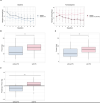Figure 1. Hand grip strength (HGS) in patients with post-infectious ME/CFS (n = 20). Handgrip strength (HGS) was assessed in two separate sets, each consisting of ten consecutive measurements, with a 1 h rest period between sets. Mean and maximum HGS were calculated for each measurement set. The visit without pyridostigmine (PS) is shown in blue, while the visit with 30 mg of PS administered after the first measurement set is shown in pink. (A) Course of the single HGS values, left: without PS, right: with PS. (B) Maximum force (Fmax2) of the second HGS measurement set, with and without PS. (C) Mean force (Fmean2) of the second HGS measurement set, with and without PS. (D) Difference in maximum force (Fmax) between the first and second measurement set. Group comparisons were performed using the Wilcoxon matched paired-signed rank test with significance levels indicated as * p < 0.05, ** p < 0.01, *** p < 0.001.

